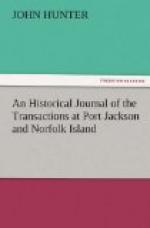-Insects_.—These have already been described. The ground is much infested by the grub-worm, which are very destructive to the growth of vegetables: they are mostly troublesome about the spring. Various methods have been tried to destroy these vermin, but without effect. The caterpillar has also been very troublesome in the spring; having destroyed acres of Indian corn and acres of wheat: they came in upon the grain quite suddenly, and after remaining three weeks, they went away with the same rapidity.
-Fish_.—The coasts of the island abound with very fine fish, which are principally the snapper, and weigh from four to eight pounds each. A few fish are at times caught from the shore; this, however, happens but seldom; so that a supply of fish must depend on the weather and the surf permitting boats to go out. In moderate weather, boats might land in Collins’s-Bay, on Phillip-Island, where a great quantity of fish might be cured, from March to September; after which time the fly prevents it.
-Seasons_.—The spring is very visible in August, but the trees on many parts of the island are in a constant succession of flowering and seeding the whole year round. The summer is very hot: I had no thermometer to determine the degree of heat, but it is excessive. From the 23d of September, 1789, to the 22d of February, 1790, not one drop of rain fell, excepting on two days in December; but it should be remarked, that we had no drought in the former year. All the grain, and the European plants seeded in December. From February to August may be called the rainy season; not that I think there is any regular time of rains during these months, as the weather is sometimes very fine for a fortnight together; but when the rain does fall, it pours in torrents. I do not recollect more than three claps of thunder, or lightning, during the time I remained on the island. The winter, (which may be said to commence in April, and end in July,) is very pleasant; there is never any frost; but when the south-west winds blow, which are very frequent and violent in these months, the air is raw and cold. It is very remarkable, that during some days in December and January, the weather has been much colder than in the winter months. The south-east, and east winds are very parching and dry, as no dew falls when those winds prevail.
-Winds_.—During the winter months, the wind is mostly from south to west, blowing with great violence for a week together; afterwards it veers round to the southward and south-east, which brings fine weather for a few days, then it veers to east, north-east, and north-west, blowing in heavy gales, and generally accompanied with violent torrents of rain: after which it shifts to south-west: indeed, I do not remember one instance of the wind coming to the north-east, round by west. The south-east wind blows during the summer with very little variation, and sometimes very strong.
-Coasts of the island_.—The coasts of the island are in general steep to, and (excepting Sydney, Anson, Ball, and Cascade Bays,) are inaccessible; being surrounded by steep cliffs, which rise perpendicularly from the sea. A number of large rocks lie scattered about close to the shore, on which a continual surf breaks with great force.




